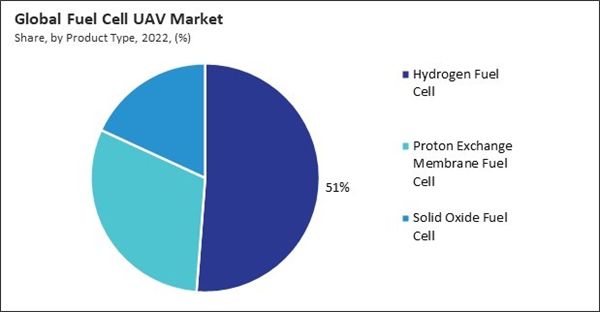The Global Fuel Cell UAV Market size is expected to reach $3.8 billion by 2030, rising at a market growth of 13.1% CAGR during the forecast period.
Governments in North America, particularly in the United States and Canada, have been investing in research and development of alternative energy technologies, including fuel cells. Consequently, the North America segment captured $760.15 million revenue in the market in 2020. This funding supports innovation in the UAV industry and encourages the adoption of fuel-cell technology. Hence, these factors can lead to enhanced growth in the upcoming years.
Fuel cell technology continues to be refined to maximize energy conversion efficiency. Durability improvements in fuel cell components, such as membranes, catalysts, and electrodes, contribute to longer service life and reduced maintenance requirements for fuel cell systems. Greater durability means fuel cell-powered UAVs can withstand harsh environmental conditions, prolonged use, and operational stresses, improving reliability and overall mission success rates. Thus, these factors can lead to increased demand for fuel cell UAVs in the coming years.
Additionally, fuel cell-powered UAVs can remain airborne for extended periods, allowing for prolonged surveillance operations over a specific area. As per the Office for National Statistics, the United Kingdom, the cost of new construction projects in Great Britain increased significantly (15.3%) in 2021 after declining by 15.9% in 2020 to reach £100,199 million. The largest drivers of the annual increase - private housing, private infrastructure, and new public infrastructure - increased by 23.7%, 28.1%, and 37.4%, respectively. Thus, these factors can assist in the growth of the market.
However, fuel cell systems rely on materials such as platinum for catalysts, proton exchange membranes, and other specialized components. The cost of these materials can be significant, particularly for high-performance fuel cell stacks. While efforts are underway to reduce the reliance on costly materials through innovation and alternative manufacturing processes, material costs remain a key factor influencing the overall cost of fuel cell technology. Therefore, these aspects can decrease demand in the market.
The market competition in the Market is intensifying as technological advancements drive innovation and market expansion. Key players in the industry are investing significantly in research and development to improve fuel cell efficiency, increase flight endurance, and reduce operating costs. Moreover, the growing demand for long-endurance UAVs in military, surveillance, and commercial applications is fueling competition among manufacturers to develop reliable and cost-effective solutions. As a result, companies are striving to differentiate themselves through product differentiation, strategic partnerships, and market expansion initiatives to gain a competitive edge in the market.
Governments in North America, particularly in the United States and Canada, have been investing in research and development of alternative energy technologies, including fuel cells. Consequently, the North America segment captured $760.15 million revenue in the market in 2020. This funding supports innovation in the UAV industry and encourages the adoption of fuel-cell technology. Hence, these factors can lead to enhanced growth in the upcoming years.
Fuel cell technology continues to be refined to maximize energy conversion efficiency. Durability improvements in fuel cell components, such as membranes, catalysts, and electrodes, contribute to longer service life and reduced maintenance requirements for fuel cell systems. Greater durability means fuel cell-powered UAVs can withstand harsh environmental conditions, prolonged use, and operational stresses, improving reliability and overall mission success rates. Thus, these factors can lead to increased demand for fuel cell UAVs in the coming years.
Additionally, fuel cell-powered UAVs can remain airborne for extended periods, allowing for prolonged surveillance operations over a specific area. As per the Office for National Statistics, the United Kingdom, the cost of new construction projects in Great Britain increased significantly (15.3%) in 2021 after declining by 15.9% in 2020 to reach £100,199 million. The largest drivers of the annual increase - private housing, private infrastructure, and new public infrastructure - increased by 23.7%, 28.1%, and 37.4%, respectively. Thus, these factors can assist in the growth of the market.
However, fuel cell systems rely on materials such as platinum for catalysts, proton exchange membranes, and other specialized components. The cost of these materials can be significant, particularly for high-performance fuel cell stacks. While efforts are underway to reduce the reliance on costly materials through innovation and alternative manufacturing processes, material costs remain a key factor influencing the overall cost of fuel cell technology. Therefore, these aspects can decrease demand in the market.
By Weight Analysis
Based on weight, the market is segmented into less than 50 Kg and more than 50 kg. The less than 50 Kg segment held the 63.61% revenue share in the market in 2022. The UAV industry has experienced significant expansion due to the expanding range of applications in diverse sectors, including but not limited to agriculture, surveillance, and cartography. This growth will likely trickle down to smaller segments, including less than 50 kg UAVs.By Product Type Analysis
Based on product type, the market is segmented into hydrogen fuel cell, solid oxide fuel cell, and proton exchange membrane fuel cell. In 2022, the solid oxide fuel cell segment garnered a 18.12% revenue share in the market. Solid oxide fuel cells offer higher energy density than other fuel cells, making them particularly suitable for UAV applications where maximizing energy output while minimizing weight and volume is crucial.By Application Analysis
On the basis of application, the market is divided into military & defense, civil & commercial, logistics & transportation, construction & mining, and others. The civil and commercial segment recorded the 32.08% revenue share in the market in 2022. Fuel cell UAVs typically offer longer flight endurance compared to battery-powered drones. This extended flight time is particularly advantageous for civil and commercial applications such as surveillance, monitoring, mapping, and delivery services, where prolonged aerial operations are required.By Type Analysis
Based on type, the market is divided into fixed wing, rotary wing, and hybrid. The fixed wing segment recorded a 21.33% revenue share in the market in 2022. Ongoing progress in fuel cell technology has substantially improved fuel cell systems' performance, efficiency, and dependability, thereby increasing their feasibility as a propulsion source for fixed-wing UAVs. Fuel cell power density, energy conversion efficiency, and durability improvements have enabled manufacturers to develop lightweight and compact fuel cell stacks suitable for integration into fixed-wing UAV platforms.By End-Use Analysis
On the basis of end-use, the market is divided into cargo UAV and others. The others segment recorded the 68.70% revenue share in the market in 2022. The rising demand for fuel cell UAVs extends beyond cargo applications to a diverse range of segments including surveillance and monitoring, environmental conservation, precision agriculture, telecommunications, and scientific research.By Regional Analysis
By region, the market is segmented into North America, Europe, Asia Pacific, and LAMEA. In 2022, the Europe segment acquired a 21.89% revenue share in the market. European governments often provide support and incentives for adopting clean energy technologies. This includes subsidies, grants, and tax incentives for companies investing in fuel cell UAVs.Market Competition and Attributes
The market competition in the Market is intensifying as technological advancements drive innovation and market expansion. Key players in the industry are investing significantly in research and development to improve fuel cell efficiency, increase flight endurance, and reduce operating costs. Moreover, the growing demand for long-endurance UAVs in military, surveillance, and commercial applications is fueling competition among manufacturers to develop reliable and cost-effective solutions. As a result, companies are striving to differentiate themselves through product differentiation, strategic partnerships, and market expansion initiatives to gain a competitive edge in the market.
Recent Strategies Deployed in the Market
- Feb-2024: Elbit Systems Ltd. has launched the HermesTM 650 Spark Unmanned Aerial System (UAS). This new system will be a new addition to the company's diverse and innovative aerospace defense portfolio. Additionally, solidify the company's commitment to advancing defense technology, ensuring security, and meeting dynamic needs.
- Sep-2023: ISS Aerospace launched the WASP M4-TL tactical UAS. The WASP will be exploited under license for defense and security applications by ISSOS Technologies Ltd., a UK company.
- Oct-2021: Plug Power, Inc. signed an agreement with HevenDrones, a leader in the development and commercialization of actionable drone platforms, to jointly develop hydrogen fuel cell-powered heavy-lift actionable drones and related support equipment and infrastructure. Through this agreement, Plug Power will expand its portfolio by making more hydrogen-powered drones and set standards for clean energy drone transportation.
- Feb-2021: AeroVironment, Inc. acquired Arcturus UAV, Inc., a leading designer, and manufacturer of high-performance unmanned aircraft systems (UAS), to maintain or exceed the high level of service our existing and new customers experience. Through this acquisition, the company will expand its portfolio of intelligent, multi-domain robotic systems.
List of Key Companies Profiled
- Doosan Corporation
- Elbit Systems Ltd.
- The Boeing Company
- Northrop Grumman Corporation
- Textron, Inc.
- AeroVironment, Inc.
- Barnard Microsystems Ltd.
- Horizon Fuel Cell Technologies
- ISS Aerospace
- Plug Power, Inc. (EnergyOR)
Market Report Segmentation
By Weight- Less Than 50 Kg
- More Than 50 Kg
- Hydrogen Fuel Cell
- Proton Exchange Membrane Fuel Cell
- Solid Oxide Fuel Cell
- Civil & Commercial
- Military & Defence
- Logistics & Transportation
- Construction & Mining
- Others
- Rotary Wing
- Fixed Wing
- Hybrid
- Cargo UAV
- Others
- North America
- US
- Canada
- Mexico
- Rest of North America
- Europe
- Germany
- UK
- France
- Russia
- Spain
- Italy
- Rest of Europe
- Asia Pacific
- China
- Japan
- India
- South Korea
- Singapore
- Australia
- Rest of Asia Pacific
- LAMEA
- Brazil
- Argentina
- UAE
- Saudi Arabia
- South Africa
- Nigeria
- Rest of LAMEA
Table of Contents
Chapter 1. Market Scope & Methodology
Chapter 2. Market at a Glance
Chapter 3. Market Overview
Chapter 5. Global Fuel Cell UAV Market by Weight
Chapter 6. Global Fuel Cell UAV Market by Product Type
Chapter 7. Global Fuel Cell UAV Market by Application
Chapter 8. Global Fuel Cell UAV Market by Type
Chapter 9. Global Fuel Cell UAV Market by End-Use
Chapter 10. Global Fuel Cell UAV Market by Region
Chapter 11. Company Profiles
Companies Mentioned
- Doosan Corporation
- Elbit Systems Ltd.
- The Boeing Company
- Northrop Grumman Corporation
- Textron, Inc.
- AeroVironment, Inc.
- Barnard Microsystems Ltd.
- Horizon Fuel Cell Technologies
- ISS Aerospace
- Plug Power, Inc. (EnergyOR)
Methodology

LOADING...











